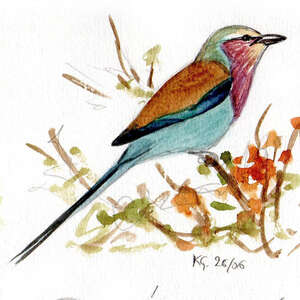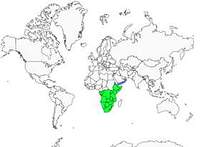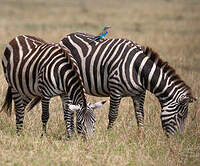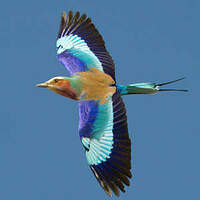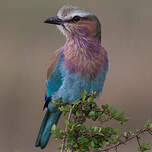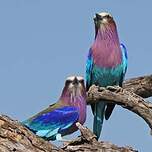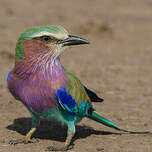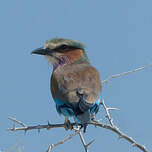Lilac-breasted Roller
Coracias caudatus - Rollier à longs brins
Identification
The sexes are similar.
The adult Lilac-breasted Roller can be recognized by its long streamers formed by the outer rectrices which extend its tail and gave it its French name. Its English name, Lilac-breasted Roller, alludes to its lilac-coloured throat and chest.
In flight, the bird is large and blue. Its wings, like all roller species, are a range of blues from cyan to indigo to royal blue. Additionally, its whole back (back, belly, and tail) is blue.
When perched, it is much less visible in flight, with the brighh colours concealed. From behind, its brownish-fawn mantle and scapulars, and from the front, its violet chest are much less noticeable.
The head is tricoloured. The face and chin are whitish, the crown and neck pale blue-green, and the cheeks chestnut. The beak is strong, slightly hooked, and black. The short legs are dull yellow.
Immature birds resemble adults, with duller colours, and do not have tail streamers.
Subspecific information 2 subspecies
- Coracias caudatus caudatus (Uganda and s and w Kenya to n Namibia and n South Africa)
- Coracias caudatus lorti (Eritrea to w Somalia and ne Kenya)
Foreign names
- Rollier à longs brins,
- Carraca lila,
- rolieiro-de-peito-lilás,
- Gabelracke,
- villásfarkú szalakóta,
- Vorkstaartscharrelaar,
- Ghiandaia marina pettolilla,
- lilabröstad blåkråka,
- Savanneråke,
- krakľa vidlochvostá,
- mandelík fialovoprsý,
- Lillabrystet Ellekrage,
- savannisininärhi,
- Gewone Troupant,
- gaig blau de clatell verd,
- kraska liliowopierśna,
- lastovičja zlatovranka,
- Сиреневогрудая сизоворонка,
- ライラックニシブッポウソウ,
- 紫胸佛法僧,
- lilabröstad blåkråka,
- 燕尾佛法僧,
Voice song and call
Habitat
Behaviour character trait
The Lilac-breasted Roller is territorial. It lives alone or in pairs, but is usually only seen on its own.
It noisily expresses its disapproval of intrusions and won't hesitate to oust other species from its territory.It hunts from a perch, usually on top of a tree, shrub, post, or any other elevated support from which it can survey its surroundings. It has been known to perch on the back of a herbivore in the absence of suitable perches.
It dives for insects at ground level and often returns to the same perch to eat its prey.
It is drawn to fires, both natural and lit, with the edge of the fire providing fleeing and dead prey that it covets.
The Lilac-breasted Roller mostly travels by flight, even for short distances, as its short legs don't really allow it to walk and instead it only does so clumsily.
Its courtship displays include short flights, the birds leaving their perch only to return quickly before flying off again. They will rise about ten metres facing each other, then fall with their wings closed, do a loop with rapid beating of the wings to rise again turning. Just before mating, when they reach the peak of excitement, the mates will engage in a simulated battle.
Flight
Dietfeeding habits
Reproduction nesting
Geographic range
Threats - protection
Sources of information
- IOC World Bird List (v14.2), Gill, F and D Donsker (Eds). 2024-04-18.
- Avibase, Lepage Denis
- BirdLife International, BirdLife International
Other sources of interest
 Specification sheet created on
29/07/2023 by Catherine et Bernard Lanneluc
Specification sheet created on
29/07/2023 by Catherine et Bernard LannelucTranslation by AI Oiseaux.net
© 1996-2025 Oiseaux.net
- Accipitriformes
- Aegotheliformes
- Anseriformes
- Apodiformes
- Apterygiformes
- Bucerotiformes
- Caprimulgiformes
- Cariamiformes
- Casuariiformes
- Charadriiformes
- Ciconiiformes
- Coliiformes
- Columbiformes
- Coraciiformes
- Cuculiformes
- Eurypygiformes
- Falconiformes
- Galliformes
- Gaviiformes
- Gruiformes
- Leptosomiformes
- Mesitornithiformes
- Musophagiformes
- Nyctibiiformes
- Opisthocomiformes
- Otidiformes
- Passeriformes
- Pelecaniformes
- Phaethontiformes
- Phoenicopteriformes
- Piciformes
- Podargiformes
- Podicipediformes
- Procellariiformes
- Psittaciformes
- Pterocliformes
- Rheiformes
- Sphenisciformes
- Steatornithiformes
- Strigiformes
- Struthioniformes
- Suliformes
- Tinamiformes
- Trogoniformes

